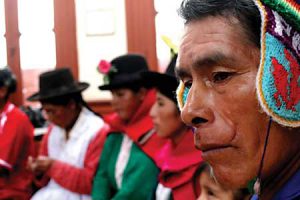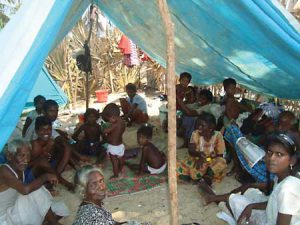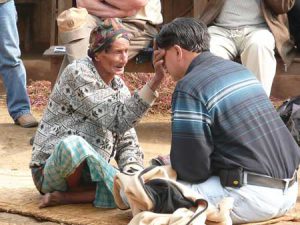
By Tamarah Feder
War, massacre, earthquake, tsunami. Numerous deaths, countless injured, an endless stream of internally displaced people and refugees flowing across the borders. Lost homes, ravaged communities, missing loved ones and a failing economy. The psychological impact of such traumatic events can emotionally devastate an individual, a family and a community and when those events are relentless in duration and compounded by the insidious assault of poverty, the negative effects on mental health can last for generations. Treating survivors in the aftermath of violence and disaster requires insight not only into the painful events and their short- and long-term consequences, but also into the social, political and cultural context in which life evolves.
Well-meaning international efforts tend to lack social and cultural relevance when it comes to treating the mental wellbeing of victims of extreme organised violence and natural disasters. The strict sciences of rebuilding a school or attaching a prosthetic leg cannot be applied in helping someone recover from torture, or from witnessing their village razed in a civil conflict. Reconstructing the mind and soul of an individual – as well as a community – cannot be achieved with a single approach and
therapies imported from the West.
A decade of healing

For 10 years, McGill’s Trauma and Global Health (TGH) program has been working closely with medical practitioners in countries where the emotional fallout of protracted wars, oppression, acute poverty and natural disasters have destroyed not just physical infrastructures, but social institutions such as families and communities and values and traditions. In partnership with the Douglas Mental Health University Institute, the program supports mental health research teams based in Guatemala, Nepal, Peru, Sri Lanka – and more recently the Gaza Strip – in addressing the unique needs of civilians in both rural and urban areas where access to mental health services is limited or restricted.
TGH applies an ecosystemic and transcultural approach to humanitarian interventions, creating a sustainable research environment that empowers local experts to deliver appropriate mental health care in regions and populations most affected.
The TGH program is focused on three areas of action: research and documentation, which is developed at the country level in collaboration with the Montreal-based TGH team members; capacity building, which provides graduate students and researchers, particularly from low- and middle-income countries, access to the means to strengthen their knowledge and skills in mental health research; and knowledge transfer, which brings people from a variety of sectors together into a two-way learning and problem-solving process.
Lay people work alongside healthcare professionals, academics and government and humanitarian agency representatives to develop strategies to overcome obstacles and innovate policies and programs aimed at building more humane and culturally sensitive interventions. This approach engages the voices of the people closest to the situations and communities, and allows insights not available in a textbook approach to mental health treatment.
Culturally sensitive
Dr. Duncan Pedersen, who launched and leads the TGH program in Canada, describes the philosophy: “Our approach to intervention is not just a medical model nor a one-size-fits-all prescriptive model; rather it is a culturally sensitive, comprehensive model of intervention and uses a participatory and integrative social approach.”
Recently, Pedersen and his team went back to Peru, a country that is still reeling from a dark period of political violence in the 1980s and 1990s. “On this trip we re-interviewed people who had been displaced but who have returned to their villages after 10 years and still were showing symptoms of post-traumatic stress disorder,” said Pedersen.

Indigenous populations in the Peruvian Amazon have some of the highest suicide rates in the country. In spite of economic improvements in Peru, there are persistent inequalities in the distribution of wealth and an asymmetry in who is actually benefitting from social programs, with a disproportionate amount of women, particularly widows, condemned to live in extreme poverty.
In Lima, TGH delivered a course on suicide prevention to 85 mental healthcare professionals based in Lima and other Peruvian cities, in collaboration with its partner Universidad Peruana Cayetano Heredia.
Reflecting on the work that has been done over the last decade and the work still to be done, Pedersen said “We’ve laid the groundwork to continue our work in countries and populations living in the context of extreme violence, interpersonal homicidal and suicidal violence, and in places where those most vulnerable, such as women, children and refugees displaced by war and torture, are in need. The next five-year cycle of the TGH program will deal with issues of social justice, global mental health, and mental health equity/accessibility.”
Pedersen expressed his growing concern about the state of affairs in the world today. “The rising social inequalities have significant short- and long-term effects on the mental health of populations around the globe. The University should play a greater role in addressing issues of human rights and security, global health equity and social justice, and also in dealing with the consequences of structural violence and war in civilian populations around the world.”
For more information about the Trauma Global Health Program please visit: www.mcgill.ca/trauma-globalhealth
The role of culture in understanding and treating pain
By Tamarah Feder

Western mental health professionals tend to refer to the Diagnostic and Statistical Manual of Mental Disorders (DSM) published by the American Psychiatric Association to diagnose and label mental disorders. But for many people suffering mental illness in non-Westernized countries – particularly those who have lived through extreme political violence and/or natural disasters – the diagnoses in the DSM may not adequately reflect their unique cultural and spiritual perceptions of health and wellbeing.
Abdel Afana, a research associate with McGill’s Trauma and Global Health (TGH) program, underscores the importance of knowing and integrating cultural idiosyncrasies to properly identify mental illness and treat patients suffering from PTSD. Afana, who obtained a doctorate in psychology from the University of Oslo, is past president of the International Rehabilitation Council for Torture Victims. He has worked closely with Palestinians living in the Gaza Strip suffering a myriad of mental disorders due to the prolonged and extreme political and societal distress.
Afana describes what might seem a semantic distinction but is, in fact, critical in understanding the nuances in how patients see their experience in its broader context. “For Palestinians living in the Gaza Strip, the use of certain terminology can provide details on the context of their suffering. For example, there are specific words that convey the environment of their pain: ‘sadma’ describes the trauma of a sudden blow that carries an immediate impact, ‘faji’ah’ or ‘tragedy’ describes an extraordinary event, mainly the loss of a loved one, and ‘musiba’ or ‘calamity’ tells of persistent traumatic events that have long-term consequences. The knowledge of and respect for distinctive references are equally important when it comes to how treatment is delivered,” said Afana.
As with many other regions in the world, differences between men and women may dictate the degree of openness and comfort when discussing intimate issues. This can pose challenges for regions where there are few female mental healthcare professionals or where deference may be made to men.
Another distinctive approach that may differ from traditional western mental health care is direct community involvement as part of the healing process of those suffering the effects of trauma. Where Western methods might focus on the healthcare professional working one-on-one with the patients, in other regions, patients are often accompanied by family members and religious advisors to sessions with a healthcare professional – all of whom play active roles in discussing the impact of the trauma – and finding ways to support each other and find the paths for healing and survival together.
Country information where the TGH Program works
Guatemala, Peru, Sri Lanka and Nepal share a history of colonization and dependency, significantly sized indigenous groups, different ethnicities and languages, and distinctive social, political, religious and cultural attributes. They all have large segments of the population living below the poverty line, persistent social inequalities, exclusionary practices against women and indigenous peoples, a history of racism and discrimination against ethnic groups, poor governance, corruption at various levels, inefficient justice systems, and above all an experience of both episodic natural disasters (i.e., earthquakes, hurricanes, tsunamis, tornados and floods) and protracted and endemic political violence, armed conflict and war. McGill’s Trauma and Global Health Program is active in all four regions.
Guatemala
Nicknamed the Country of Eternal Spring, the Central American Guatemala is homeland of over 12 million people, the majority of whom are either indigenous or mestizos. From 1960 to 1996, the country was in a state of perpetual civil unrest n which massacres and other atrocities were inflicted on its indigenous Mayan populations, pitting left-wing insurgents against military forces. Over 200,000 people – mostly of Mayan origin – were killed or disappeared. About a million were forcibly displaced, a third of whom found refuge just over the Mexican border. Although an agreement in 1996 produced a cease fire and a fragile peace accord, the country is still plagued by structural violence as well as organized crime.
Peru
Once the seat of the ancient Inca Empire, contemporary Peru is home to a multi-ethnic population of over 28 million – a citizenry as varied as its terrain. Between 1980 and 2000, Peru underwent a protracted period of extreme political upheaval in which around 70,000 people were killed or disappeared. The region is also prone to natural disasters, including earthquakes, floods, severe droughts, landslides, and mild volcanic activity. In August 2007, Peru’s coastal areas were hit by an earthquake that killed over 500 people, injured over 1,000, and left 100,000 homeless.
Sri Lanka
Sri Lanka, an island state in the Indian Ocean, is home to over 20 million people. It has a rich and diverse culture, but from 1983 to 2009, the country was divided by ethnic conflict in which 70,000 people were killed. Sri Lanka is also vulnerable to natural disasters and in December 2004, the most deadly tsunami in the country’s history took more than 31,000 lives and left 835,000 homeless.
Nepal
Nepal’s population of 27 million live on a relatively a narrow strip tucked between China and India. From 1996 to 2006, Nepal’s political terrain was as jagged as its natural landscape. That decade saw a civil war that claimed 13,000 lives. Thousands were tortured and between 100,000 and 200,000 people were internally displaced. Although the conflict ended with the elimination of the monarchy and a ceasefire three years ago, political tensions continue to threaten the health and security of the population. In addition to the traumatic experiences caused by ethnic conflict, the region is also prone to severe weather, flooding, and landslides.
